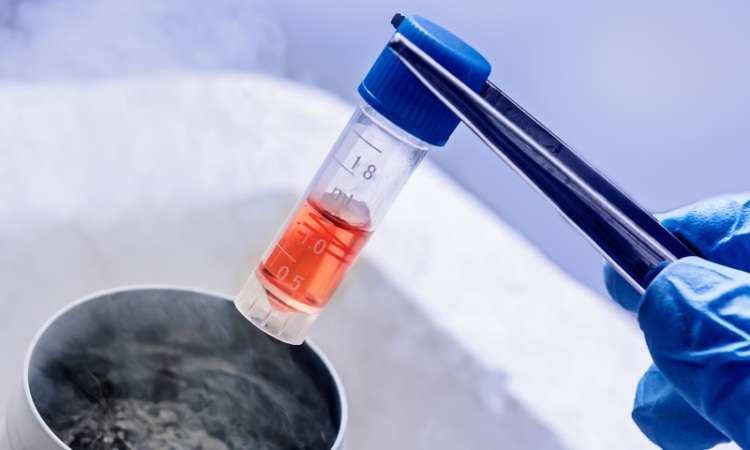
The cell cryopreservation market plays a vital role in preserving and safeguarding various cell types for applications in research, regenerative medicine, and assisted reproductive technology. The cell cryopreservation market plays a pivotal role in regenerative medicine, assisted reproductive technology, and biobanking. The cell cryopreservation market is expected to grow at a CAGR of 21.5% during the forecast period of 2025 to 2033. While technological challenges exist, the market continues to grow due to the expansion of regenerative medicine, ART, and research activities. Competitive trends suggest that established players are well-positioned to meet the evolving demands of the market, supporting the storage and utilization of cryopreserved cells for various applications in healthcare and research.

Rise in Regenerative Medicine
The growing interest in regenerative medicine and cell-based therapies is a major driver of the cell cryopreservation market. Cryopreservation enables the long-term storage of valuable cells, including stem cells and primary cells, for potential therapeutic use. This driver is supported by the increasing number of clinical trials and research activities in regenerative medicine, with a focus on personalized cell therapies. Evidence for this driver can be observed in the surging investments and collaborations in the regenerative medicine sector.
Expansion of Assisted Reproductive Technology
The expansion of assisted reproductive technology (ART), including in vitro fertilization (IVF), has driven the demand for cryopreservation of oocytes, embryonic cells, and sperm. Cryopreservation ensures the availability of viable reproductive cells for patients undergoing fertility treatments. This driver is evident in the rising global infertility rates, the acceptance of cryopreserved embryos, and the growth of ART centers. Evidence for this driver can be seen in the increasing utilization of cryopreserved reproductive cells in IVF procedures.
Biobanking and Research Advancements
Biobanking and research activities have surged, requiring reliable methods for long-term cell storage. Cryopreservation serves as a crucial tool for biobanks and research institutions to maintain cell lines and tissue samples. This driver is supported by the expansion of biobanking networks and the development of biorepositories for medical research. Evidence for this driver can be observed in the increasing utilization of cryopreserved samples in research and drug development.
Technological Challenges
The cell cryopreservation market faces challenges related to the technological aspects of freezing and thawing cells. While cryopreservation has advanced significantly, the process can still result in cell damage and reduced viability upon thawing. This limitation hinders the potential of cryopreserved cells for certain applications, such as regenerative medicine. Evidence for this restraint can be seen in instances where the post-thaw recovery of cells remains a concern.
By Product (Cell Freezing Media, Equipment, Consumables): The cell Cryopreservation Market Dominates the Market
In 2024, the cell cryopreservation market witnessed substantial revenue from Cell Freezing Media. However, during the forecast period from 2025 to 2033, Consumables are expected to exhibit the highest Compound Annual Growth Rate (CAGR). This indicates the demand for reliable consumables in cryopreservation processes, including vials, cryobags, and other essential components.
By Application (Stem Cells, Oocytes, Embryotic cells, Sperm Cells, Hepatocytes, Others): Stem Cells Dominate the Market
In 2024, various cell applications contributed to the market's revenue. Notably, Stem Cells generated the highest revenue in 2024. Looking ahead to the period from 2025 to 2033, Oocytes and Embryotic cells are projected to have the highest CAGR. This reflects the continued growth of assisted reproductive technology and the need for cryopreserved reproductive cells.
North America Remains the Global Leader
The cell cryopreservation market exhibits distinct geographic trends. In 2024, North America led in terms of revenue, contributing significantly to the market. The region with the highest revenue percentage in 2024 was North America. However, looking ahead to the period from 2025 to 2033, the Asia-Pacific region is expected to have the highest CAGR. This reflects the growing interest in regenerative medicine and assisted reproductive technology in the Asia-Pacific region, along with increasing investments in research and biobanking.
Market Competition to Intensify during the Forecast Period
In the competitive landscape of the cell cryopreservation market, top players such as Thermo Fisher Scientific, Merck KGaA, Stemcell Technologies Inc, Sartorius AG, PromoCell GmbH, Lonza, HiMedia Laboratories, Creative Biolabs, Corning Incorporated and BioLife Solutions Inc. have consistently demonstrated their leadership. These industry leaders reported substantial revenues in 2024, and their strategies for the forecast period from 2025 to 2033 are expected to focus on product innovation, quality assurance, and expanding their presence in emerging markets. Competition among these key players intensifies, driving innovation and access to cryopreservation solutions.
Historical & Forecast Period
This study report represents analysis of each segment from 2023 to 2033 considering 2024 as the base year. Compounded Annual Growth Rate (CAGR) for each of the respective segments estimated for the forecast period of 2025 to 2033.
The current report comprises of quantitative market estimations for each micro market for every geographical region and qualitative market analysis such as micro and macro environment analysis, market trends, competitive intelligence, segment analysis, porters five force model, top winning strategies, top investment markets, emerging trends and technological analysis, case studies, strategic conclusions and recommendations and other key market insights.
Research Methodology
The complete research study was conducted in three phases, namely: secondary research, primary research, and expert panel review. key data point that enables the estimation of Cell Cryopreservation market are as follows:
Market forecast was performed through proprietary software that analyzes various qualitative and quantitative factors. Growth rate and CAGR were estimated through intensive secondary and primary research. Data triangulation across various data points provides accuracy across various analyzed market segments in the report. Application of both top down and bottom-up approach for validation of market estimation assures logical, methodical and mathematical consistency of the quantitative data.
| ATTRIBUTE | DETAILS |
|---|---|
| Research Period | 2023-2033 |
| Base Year | 2024 |
| Forecast Period | 2025-2033 |
| Historical Year | 2023 |
| Unit | USD Million |
| Segmentation | |
Product
| |
Application
| |
End-Use
| |
|
Region Segment (2023-2033; US$ Million)
|
Key questions answered in this report